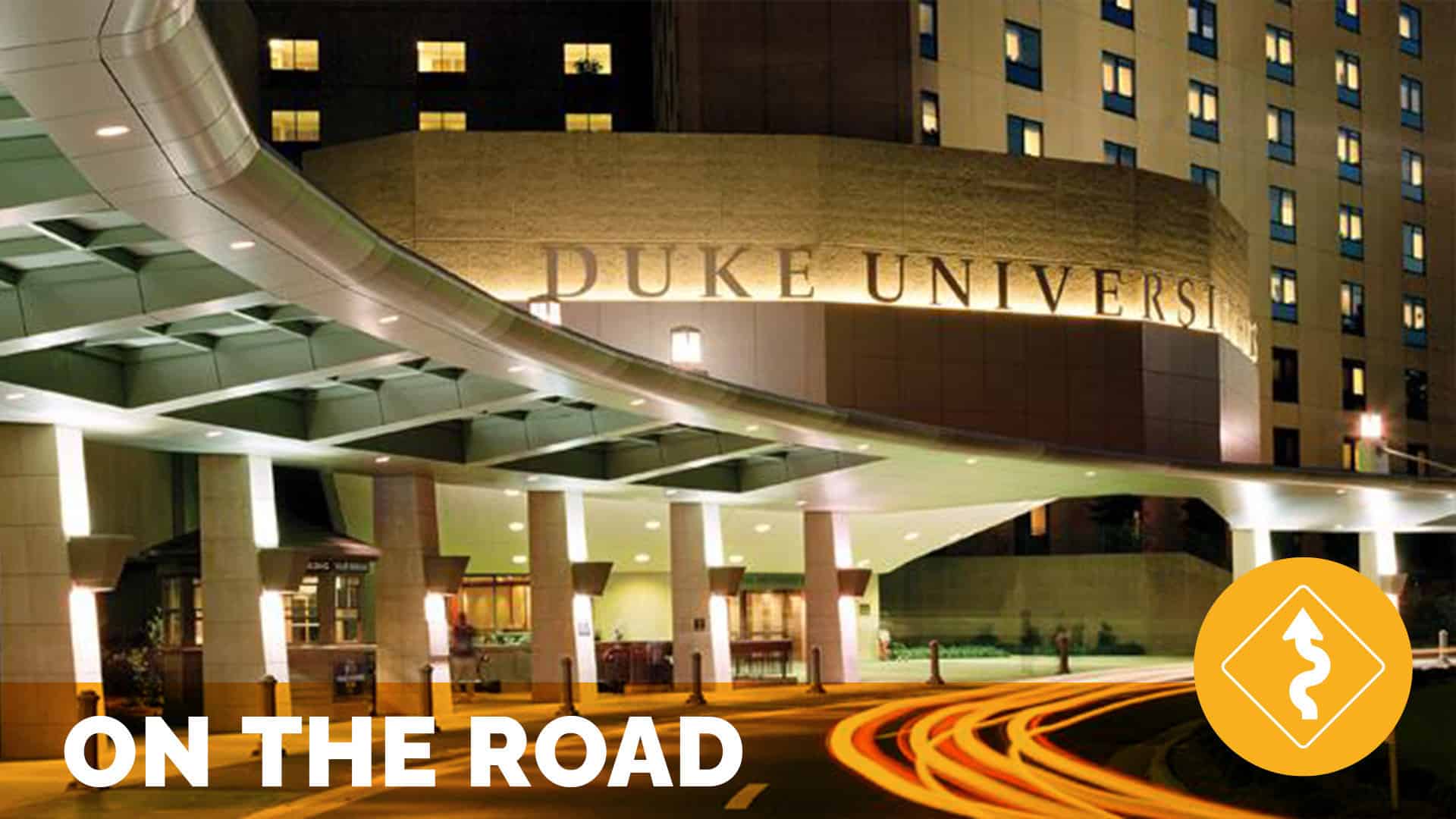A Commitment to the Whole Person
Published May 1, 2016


On the Road with Duke University Hospital – May 2016
by Jason Wolf
I recently had the chance to visit the team at Duke University Hospital for an exploration into both the challenges and opportunities they felt they were facing as they tackle the critical issue of patient experience (PX). What I found was an organization, committed as so many are, to drive excellence in experience, while facing the typical challenges posed by so many addressing this issue in healthcare organizations around the world such as, competing priorities, accountability and sustainability, consistency and even simplicity.
What stood out for me was that while they knew the critical actions to take and were transparent about the challenges, there was a strength and pride in what the organization represented that provided fuel for this endeavor. As one individual shared, “the uncommon is common here”. What I experienced in my visit was an organization with an unwavering commitment to this work and a focus that stretched beyond experience strategies and tactics to one that honored the whole person in their healthcare encounter.
A Collaborative Approach – The Patient Experience Oversight Team
During my visit I was honored to meet with and engage in conversation with the PX Oversight Team. This group represents a multidisciplinary and cross-functional collection of individuals with a commitment of exploring, identifying and then driving organizational efforts across the organization. What stood out for me was the candor and commitment with which these individuals tackle the PX conversation. Being both reflective in offering the organization’s strengths and in their understanding of opportunities to be addressed the group was working with intention to drive the best results possible.
As with many organizations today, and as outlined in our recent State of Patient Experience research, formal structure seems to be the primary means by which patient experience is tackled in organizations today. While the mandate for action appears in less cases than there are formal efforts in place to address it, and only half of all organizations have a clear purpose (definition) of what they want experience to be for their organization, what I appreciated about this team was their realistic approach to the work.
Having a solid understanding of the supports and constraints of your organization is tantamount to patient experience success. How to address those opportunities is the critical second step. But what we cannot miss in this effort and what was well exemplified by the effort at Duke was the important need to bring together a broad range of voices both to ensure all voices matter and develop a comprehensive and thoughtful effort that understands the broad challenges of the organizations before it ever moves to action.
What lesson the team offers us is first that breadth of perspective matters, not just for the planning process, but perhaps more importantly for the execution of ideas. This poses unique challenges as the competing priorities embedded in the organization can easily come to light by the key players engaged. I would offer this also provides the opportunity for spotlighting those potential conflicts in order to address them prior to becoming an issue.
The PX Oversight Team at Duke would be the first to tell you their efforts represented a work in progress. The reality of patient experience work is that it is (and should be) consistently a work in progress. Yet this team represented an opportunity many organizations overlook. They may establish a committee or steering team, but yet miss the richness and breadth the Duke team represented. Mind you, a PX team alone is not the answer to all the goals you may have, but it is a way to align forces on solutions, collaboration and communication in a way that is fundamental to patient experience success.
This commitment on understanding and working the issue set up my visit and what I hoped to explore. Rather than share every tactic or process in place, I chose, as the team inspired me to do, to look for how the organization committed to efforts beyond just PX tactics, to understanding the whole person in their midst. I will pull just a few examples to reinforce this as a critical component of any patient experience effort.
Caring for the Whole Person
Aside from a beautiful new and growing environment Duke University Hospital was working on personal, spiritual and aesthetic touches to positively impact the experience of those in their care. Three items I look to specifically address, among the many things I experienced were the environment of healing at Duke Cancer Center, the personal touch of concierge services at Duke Hospital and a powerful example of the humanity in healthcare brought to life via the Arts & Health program.
Duke Cancer Center
My time at the Cancer Center began with an incredible welcome as volunteers and staff alike worked hard to ensure everyone entering the building not only was acknowledged and welcomed, but they were guided to where they needed to be. Perhaps most impressive to me in this effort was the clear recognition that the team welcoming people had for those entering the center. For those patients undergoing frequent treatments or spending extended time at the facility I saw people welcomed by name and engaged in personal stories and updates as they headed off to appointments or treatment.
This human environment was supported by a great sense of how the highly trafficked physical space was used. Clinics, treatments and other efforts were streamlined in a way that brought order to a rather busy lobby and created comfort in a time that would feel both disorienting and discomforting for so many.
While the activity in the space was palpable, it was never overwhelming. It was blanketed by an incredible performance of live music emanating from the ground level of a grand atrium filling the public space with warmth and drawing people to a labyrinth for both personal and spiritual focus.
This duality of personal and spiritual focus was continued in an incredibly unique and well thought out quiet room in the center. Partly a place of worship the space was primary a place of respite and rest for those being treated or supporting them, friends, family and even staff. It was an incredibly soothing environment and a place of peace in a building that more often saw the direct opposite in anticipation, tension, and even fear.
A Care(ing) Concierge
As we entered the main facility on our brief return walk from the Cancer Center, we were once again greeted warmly by the individuals at the front desk, but in addition we stepped into the beautiful family lounge just off the main lobby. The key here is not just having a lounge and resource center such as this, it is how the space was being used and who was guiding it that was impressive.
The concierge I had the chance to meet, Rosa Jimenez, exemplified pure energy in her commitment to serving those visiting the facility. While conducting many of the practices one would find typical of concierge services, one program in particular stood out. Primary to her job and an incredibly valuable practice was that of “host homes” through which Rosa identified and manages home stays for family and loved ones who are staying extended periods of care. These short-term home stays are offered free or at a nominal charge to participants and represent a valuable forward thinking example of how we can both anticipate and provide for experience well outside the clinical arena, even while being in its midst.
This commitment to both acknowledging and then acting to support the wholeness of the patient and family experience is significant. Far too often we still relegate experience to a segment of the care encounter, overlooking the breadth that experience encompasses. The intentionality of the effort at Duke University Hospital underscores the importance of and value these types of offerings can bring to the overall patient experience.
Arts & Health
Perhaps the most intriguing and unique aspect of caring for the whole person I encountered during my visit was Duke’s commitment to the aesthetic nature of the care environment, but physically and personally. Through their leading and innovative Arts & Health program the organization worked to do just that. If you are looking for a means to address the humanity in your organization this is an example not to be overlooked. Much more than the incredible value music therapy brings to the care experience, this program looks to impact almost all the senses in grounding both patients and families as well as staff and the community in the importance of thinking about experience in the broadest sense.
As shared in my time with members of the Arts & Health team and reiterated on their comprehensive website, the history of the program is rich and long. Arts & Health at Duke was founded in 1978 by James H. Semans, MD, in collaboration with Wayne Rundles, MD, professor of hematology and then-president of the American Cancer Society. First known as Cultural Services, the program originally offered monthly musical performances in the hospital cafeteria with the support of the Mary Duke Biddle Foundation. With a successful grant from the National Endowment for the Arts, additional funds from the Mary Duke Biddle Foundation, and the support of hospital administration, the program was officially organized in October 1978. Programming expanded to include not only performing arts but also the acquisition of visual art for patient rooms and waiting areas and a literary arts program that offers journaling and poetry programs. The program continues to thrive to this day, almost now 40 years later.
The power of this program is in the triad of offerings that each on their own has great reach into the Duke experience through literary, performing and visual arts. Before even meeting the team from Arts & Health team I was privy to their impact. From art that brought life both to the facilities’ public spaces to patient rooms to the incredible music I noted emanating in the atrium of the Cancer Center to an incredible solo string performance echoing through the main concourse, a central artery connecting all of Duke’s facilities. It was an experience that turned the journey, which in many facilities could feel daunting or even disorienting, into one in which the travel flowed seamlessly carried on the notes filling the space.
These subtle yet significant touches to the experience at Duke reinforce the very humanity upon which we build healthcare. As human beings caring for human beings these efforts work to reinforce the very essence of the people who comprise and engage in healthcare. In having a chance to meet with two of the Arts & Health team members I was exposed to not only the passion that drives this work, but the creativity and contribution it brings to the experience Duke offers. William Dawson, Performing Artist In Residence, brings music to the masses by managing the performing arts efforts across the campus and works to educate others. He offered his take on the program. “Its about the humanity of what we do [in healthcare],” he said. “I just want to meet you where you are.”
In fact William ensures over 33 hours of music are heard in public spaces each week and even works to provide music lessons at the bedside. His signature program, “Put the ‘Uke’ in Duke” actually brings ukulele lessons to patients and families in a way that in minutes they are playing music themselves. A powerful reminder that in all that challenges us in healthcare as patients or families, these individuals encompass and aspire to much more.
I also had the chance to meet Katja Hill, Literary Arts Coordinator. Her purview covers a core set of programs that bring the literary arts to life for patients and families. Most prominent of them is the journaling program, Write for You. This program distributes free journals to patients and family members so they can capture their thoughts, whatever they might be. People write everything from notes of their care journey to creative writing, poems and more. The program looks to create the opportunity to capture these thoughts with the intention of reducing stress, improving engagement and impacting health (of mind, body and spirit). They bring these resources to patients and families as well through weekly workshops to both encourage and support people’s interest in this effort. In asking Katja what she saw as the greatest value in this program she offered, “People want to tell their stories, they want to be heard.”
This is a powerful example of how in experience sometimes it may be the very ideas that seem to rest at the edges that can actually have the greatest impact on the core of what we do. The Arts & Health program at Duke University Hospital underlies that very message. That the essence of experience itself is not just in the clinical choices we make. While vital, we must always care for the whole person in our midst.
A Commitment to More than Clinical Care
As my hosts Brenda Radford and Pam Turner guided me throughout the facility, and I met with leaders, caregivers and engaged with patients and families, I was reminded that it takes the fully integrated efforts we strive for in healthcare every day to truly impact experience. Yes we have clinical commitments first and foremost, but those must be wrapped in the humanity with which we both bring and hope to recognize in others. The essence of what I encountered at Duke was a recognition that even as they wrestle with what so many others do, in working through aligned content, competing priorities and a commitment to focus, we can and must never forget that at the heart of all we do is caring for the person and their family or support network right in front of us. That requires we look beyond protocol and process to the very nature of why we do what we do in healthcare every day. It is a call to purpose and one that requires we never forget the whole person we hope to help and/or heal.
Thanks to the entire team at Duke University Hospital for their gracious welcome and openness in sharing the opportunities and challenges they face. Thanks as well for stretching the view of experience for others to reflect and learn as well. Special appreciation to Brenda Radford my host and a committed leader in The Beryl Institute community for being a thoughtful guide on the journey.
Related content
-
Infrastructure & Governance | Staff & Provider Engagement
At the Ready! An Innovative Volunteer Float Pool and Its Positive Ripple Effects
Published November 20, 2025

Have you ever faced an urgent request from a colleague, knowing the perfect volunteer to fill their request but unsure if they are onboarded, trained, and available? This session will explore the creation and implementation of the “At the Ready!” volunteer float pool at Mount Sinai Hospital, highlighting its transformative impact on our response to
Learn more -
Culture & Leadership | Infrastructure & Governance
Experience Management Everywhere
Published May 15, 2025

Complimentary – The healthcare industry continues to evolve. Patient expectations evolve along with it. Patient Experience (PX) teams must evolve as well to address current challenges and proactively position themselves for continued impact. To remain relevant and impactful, next-generation experience teams must democratize experience management, ensuring the appropriate ownership at every organizational level. Attend this
Learn more -
Infrastructure & Governance
Experience Framework Lens: Infrastructure and Governance
Published March 26, 2025

Experience Framework Lens: Infrastructure and Governance Effective experience efforts require both the right structures and processes by which to operate and communicate and the formal guidance in place to ensure sustained strategic focus. The Why: Patients should be involved in healthcare governance because their lived experiences and perspectives help create a more patient-centered system. P/F
Learn more
